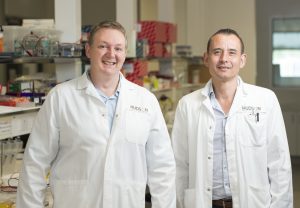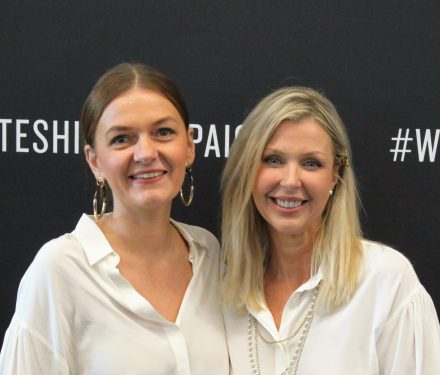Ovarian cancer screening test underway for 300 patients
A clinical trial of a screening test developed by Hudson Institute scientist, Dr Andrew Stephens to detect ovarian cancer in its early stages is about to start in a large group of Victorian and South Australian women, thanks to funding from the Ovarian Cancer Research Foundation (OCRF).
About 300 women will be recruited to the three year trial to test if the method developed in the lab to diagnose high-grade serous ovarian cancers – the most common type of ovarian cancer – works in practice.
Dr Stephens’ trial involves at-risk women who have decided to have prophylactic surgery to remove their ovaries and fallopian tubes, because of changes in their BRCA1 or BRCA2 genes that predispose them to breast or ovarian cancer. Crucially, the study will also examine these removed fallopian tubes for pre-cancerous lesions, as this is where this type of ovarian cancer is believed to start.
“It is only in the past few years we have understood that most of these tumours arise in the fallopian tubes,” Dr Stephens said. “I am hopeful we will be able to detect changes at that early point, which would give women the best therapeutic outcomes. This would be a similar approach to a cervical screening test, which detects pre-cancerous lesions of the cervix.”
Unlike other cancers which can be diagnosed by effective screening at an early stage (e.g. cervical cancer by a cervical screening test or breast cancer by mammography), an early detection test for ovarian cancer does not exist.
The screening test developed by Dr Stephens is designed as a cervical swab test, but blood-based versions are also being investigated.
Dr Stephens’ research has found that ovarian cancers are very good at hiding from the immune system. His team identified a protein produced early on by the tumours which should sound an alarm to activate the immune system, but these molecules were not working properly in ovarian cancer tissues. A change in the molecule meant the immune system was switched off instead of on.
“Our ‘Active Ratio Test’ is based around that finding,” Dr Stephens said. “It measures those specific changes to give an indication of the presence of a growing tumour. The reason we are excited about it is because we detect the largest amount of that change at the earliest stage, when the cancer is still confined to the ovary.”
“Ultimately what we want to do is to get the test into a routine screening program as a regular health check for women,” Dr Stephens said.
“I want to see my research actually get into the clinic and help women. It’s so confronting when you meet ovarian cancer patients, you meet the loveliest people, they tell you their story, and it’s very motivating. It makes you want to fix it,” he said.
Ovarian cancer facts
Ovarian cancer is the deadliest gynaecological disease. Every year, more than 1600 Australian women are diagnosed with the disease and it claims the lives of more than 1000. It is known as the silent killer, as women with early stage ovarian cancer commonly do not present with any symptoms. This means the disease is often not detected until the advanced stages when it has spread beyond the ovaries, with the five-year survival rate a devastatingly low 45 per cent.
Granulosa cell tumour therapy
Another Hudson Institute researcher, Dr Simon Chu, has also been awarded funding from the OCRF. Dr Chu is one of the leading researchers internationally investigating an uncommon type of ovarian cancer dependent on hormones, called granulosa cell tumours. These tumours produce hormones and often the first indication a woman has this type of cancer is when abnormally high levels of oestrogen are detected. The cancer is often successfully treated, but can recur between five to 20 years later, when it becomes resistant to chemotherapy.
Dr Chu is investigating better treatments for these types of ovarian cancers, which may also be applicable to some of the more common ovarian cancers. His approach looks at the over-expression of a particular protein in ovarian cancer (XIAP) which appears to protect a tumour cell from dying.
He is investigating the use of a combination therapy, which inhibits the problematic protein XIAP before sensitising it to a further hit from another drug to cause the cancer cell death. Dr Chu has personally been touched by ovarian cancer, which claimed the life of a close family member, and he draws on his expertise in both cancer research and endocrinology to fight this disease.
OCRF chair Ms Julie Toop said the research projects funded this year including those from Hudson Institute were exciting, diverse and promising. “Ovarian cancer is an insidious disease that often strikes without warning. Across Australia, one woman dies every eight hours from this disease. The key to changing this statistic and giving women with ovarian cancer a better long-term outlook is early detection and innovative new treatments.
“We are excited by the unique approaches taken by these leading researchers and are hopeful the research we support will become a reality to detect this disease early and treat it effectively, so women can continue to lead long and fulfilling lives.”
Dr Stephens and Dr Chu are among the seven scientists from around Australia to be awarded a share of $2.8 million in funding from the Ovarian Cancer Research Foundation (OCRF).
The OCRF is the leading funder of ovarian cancer research in Australia. OCRF grants support scientists undertaking critical research work, help build cutting-edge laboratory environments and enable the retention of scientific expertise in a drastically underfunded field of cancer research.
Contact us
Hudson Institute communications
t: + 61 3 8572 2697
e: communications@hudson.org.au




